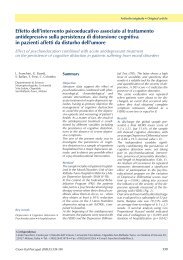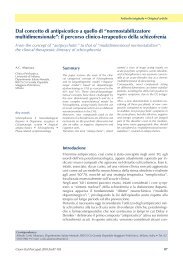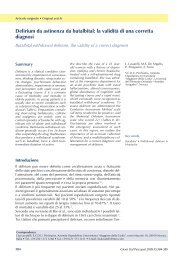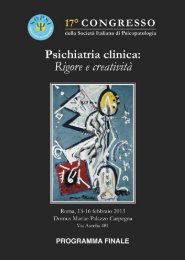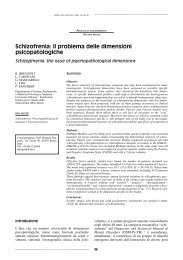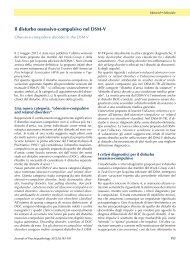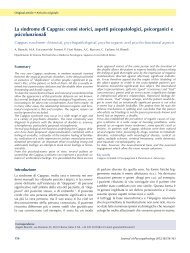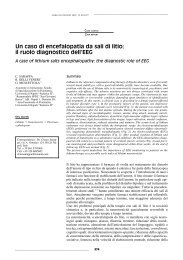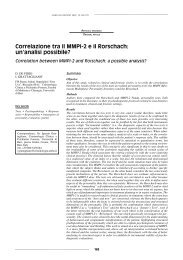XI Congresso della Società Italiana di Psicopatologia Psichiatria ...
XI Congresso della Società Italiana di Psicopatologia Psichiatria ...
XI Congresso della Società Italiana di Psicopatologia Psichiatria ...
Create successful ePaper yourself
Turn your PDF publications into a flip-book with our unique Google optimized e-Paper software.
23 FEBBRAIO 2005 - ORE 14.15-15.45<br />
SALA CAVALIERI 3<br />
S30 - Creatività artistica e Disturbo Bipolare<br />
Disturbo Bipolare e creatività artistica:<br />
scrittori e poeti<br />
SIMPOSI TEMATICI<br />
G. Perugi<br />
Dipartimento <strong>di</strong> <strong>Psichiatria</strong>, Università <strong>di</strong> Pisa, Istituto <strong>di</strong><br />
Scienze del Comportamento “G. De Lisio”, Pisa<br />
Introduzione: l’esistenza <strong>di</strong> un rapporto stretto tra creatività<br />
artistica e Disturbo Bipolare (DB) è stata ampiamente<br />
riportata nella letteratura psichiatrica. Quale sia il rapporto<br />
tra creatività e caratteristiche cliniche del DB non è ancora<br />
del tutto chiaro. Fasi <strong>di</strong> malattia, decorso, caratteristiche<br />
temperamentali sembrano svolgere un ruolo <strong>di</strong>fferente in artisti<br />
<strong>di</strong>versi. L’analisi dei testi <strong>di</strong> alcuni scrittori e poeti può<br />
fornire in<strong>di</strong>cazioni illuminanti in proposito.<br />
Metodo: rassegna <strong>della</strong> letteratura su Pub-Med alle parole<br />
chiave Disturbo Bipolare creatività artistica. Ricerca manuale<br />
<strong>di</strong> capitoli su libri o riviste non in<strong>di</strong>cizzate.<br />
Risultati: un aumento <strong>della</strong> creatività sembra riscontrarsi<br />
durante le fasi espansive attenuate del DB (ipomania) ed<br />
una <strong>di</strong>minuzione in quelle depressive, anche se in alcuni<br />
casi è riportato un incremento <strong>della</strong> creatività anche in<br />
queste ultime. La presenza <strong>di</strong> una <strong>di</strong>sposizione temperamentale<br />
<strong>di</strong> tipo ciclotimico sembra favorire la creatività,<br />
come pure i frequenti cambiamenti <strong>di</strong> fase. Infine da alcuni<br />
Autori è riportato un significato terapeutico del lavoro<br />
creativo.<br />
Conclusioni: la malattia maniaco-depressiva sembra rappresentare<br />
un terreno favorente l’espressione creativa in<br />
molti campi artistici. In particolare in molti scrittori e poeti<br />
emerge come le variazioni d’umore e l’instabilità temperamentale<br />
<strong>di</strong> tipo ciclotimico favoriscano la creatività. In alcuni<br />
casi è riportato anche un significato auto-terapeutico<br />
dell’attività artistica, che sembra in grado <strong>di</strong> modulare la<br />
gravità delle oscillazioni dell’umore.<br />
La Bipolarità nell’opera <strong>di</strong> compositori<br />
M.L. Figueira, V. Ramos<br />
Clinica Psichiatrica dell’Università <strong>di</strong> Lisbona<br />
In the present communication the relationships between<br />
some patterns of musical creativity and mood bipolar <strong>di</strong>sorder<br />
are analysed. Taking as para<strong>di</strong>gm the life and works of<br />
Robert Schumann and Hugo Wolf, the following factors will<br />
be described: 1) some important aspects of the composer’s<br />
life and personality; 2) temperamental traits and episodes of<br />
Bipolar <strong>di</strong>sorder; 3) the rate of musical productions and the<br />
mood episodes; 4) elements of bipolarity in the musical<br />
compositions.<br />
Finally, the data present is contextualized in reference to the<br />
emotional and existential clime of the romantic period.<br />
MODERATORI<br />
M. Di Fiorino, Z. Rihmer<br />
Bipolarity in the works of painters<br />
Z. Rihmer, X. Gonda, A. Rihmer *<br />
National Institute for Psychiatry and Neurology, * Department<br />
of Psychiatry, Semmelweis University, Budapest<br />
In contrast to earlier beliefs, ie. that scientific and artistic creativity<br />
is linked to schizophrenia, recent systematic empirical<br />
<strong>di</strong>agnostic stu<strong>di</strong>es have clearly shown a strong association of<br />
giftedness and creativity with affective (particularly with<br />
Bipolar II) <strong>di</strong>sorder. The creativity seems to be related to extreme<br />
affective temperaments (mostly to cyclothymic traits)<br />
rather than to major mood episodes. Almost half of the worldfamous<br />
painters have moderate or severe depressive illness,<br />
(sometimes resulting in suicidal behaviour) and the majority<br />
of them show full-blown bipolar or bipolar spectrum <strong>di</strong>sorder.<br />
The course of bipolar mood <strong>di</strong>sorder can seriously affect the<br />
quantity and quality of the paintings, and the behavioural consequences<br />
of the <strong>di</strong>sorder can basically influence the interpersonal<br />
and financial relationships of the artists.<br />
Like other creative persons, painters have increased productivity<br />
(and use a variety of colours) during hypomanic or<br />
“well” periods, while during depression, they produce less<br />
paintings (and use mainly few, primarily dark colours).<br />
Creatività e Disturbi Mentali<br />
M. Di Fiorino, M. Martinucci<br />
Reparto <strong>di</strong> <strong>Psichiatria</strong> <strong>della</strong> ASL <strong>di</strong> Viareggio<br />
Il tema <strong>della</strong> relazione tra il genio e la follia affonda le ra<strong>di</strong>ci<br />
nella me<strong>di</strong>cina classica greca per ripercorrere poi tutta la<br />
cultura occidentale.<br />
Aristotele si interroga sul legame tra creatività e melancolia.<br />
Cesare Lombroso con “L’Uomo <strong>di</strong> genio” (1891) fa risaltare<br />
<strong>di</strong> nuovo il rapporto tra genialità e tutte le malattie mentali,<br />
all’interno <strong>di</strong> una concezione <strong>di</strong> degenerazione.<br />
In questo ambito <strong>di</strong> stu<strong>di</strong>o l’approccio evidence based è reso<br />
<strong>di</strong>fficile da una non universale definizione, psicometricamente<br />
standar<strong>di</strong>zzata, <strong>di</strong> creatività (Goodwin e Jamison, 1990).<br />
Negli stu<strong>di</strong> ve<strong>di</strong>amo esplorati le persone creative <strong>di</strong> per sé,<br />
il processo creativo e il prodotto <strong>della</strong> creatività.<br />
Nella presentazione analizziamo il <strong>di</strong>battito che fa seguito a<br />
proposte <strong>di</strong> una serie <strong>di</strong> misurazioni, alcune alquanto aspecifiche<br />
e molto <strong>di</strong>fferenti tra <strong>di</strong> loro (Ludwig, 1992).<br />
Spesso le ricerche hanno riguardato casi clinici che già avevano<br />
l’associazione creatività <strong>di</strong>sturbo mentale.<br />
Alcuni stu<strong>di</strong> si basano sull’esame <strong>di</strong> scritti biografici (postmortem)<br />
o autobiografici.<br />
Tra le persone creative oltre ai bipolari sono stati descritti<br />
altri <strong>di</strong>sturbi come la depressione, i <strong>di</strong>sturbi <strong>di</strong> personalità, i<br />
<strong>di</strong>sturbi da uso <strong>di</strong> sostanze e anche la Schizofrenia.<br />
80




